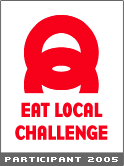
Eat Local Challenge: warm ups
In line with the recommendations of the Locavores, I'm getting mentally ready, and defining my own level of commitment. So far I've got three exceptions:
1. Coffee
2. Everything already in my pantry. Since I have a ton of olive oil, beans, rice, salt, pepper and so on this seems very much cheating. There will be no stocking up, but I am going to use what I already have. It doesn't make any sense to me, or to the mission of this thing, to waste food.
3. Wednesday night secret dinner club meetings. I'd tell you more but then I'd have to kill you.
Since I'm pretty close to eating locally already - all meat, veggies, milk, eggs - I'm not too concerned about my success with this endeavor, except for one very strong anxiety: bread.
A couple bizarrely overlapping resources if you are working on your own challenge:
Local Harvest
Food Routes
The best source of info about the challenge and about eating locally is the blog Life Begins at 30
Small Farms points out this relevant diner, in Barre, Vermont: Farmer's Diner. It's not in my local scene, being 69 miles over the 100 mile limit, but for someone else, I think it certainly counts. I was impressed with this quick clean argument for local eating:
Buying and selling so much local food creates significant social returns. Every $1,000,000 in annual sales at a diner translates into 350 acres of farmland in production, 15 farmers with gross sales of $50,000, 13 new farm jobs, and $1,200,000 in land conservation costs saved. Because of local production and shortened delivery routes each $1 million in sales saves at least 10 tons of carbon dioxide emissions annually. (Johnson School of Business, Cornell University Social Venture Competition study 2001/2002)
That is, if you find farmland and open spaces desirable in your community, which I do.
Comments